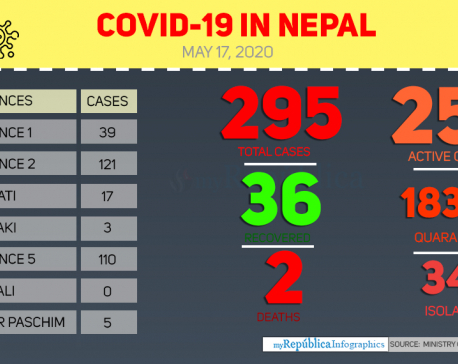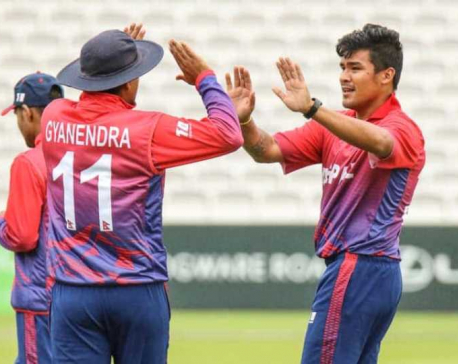
OR

Despite being rocked by one scandal after another, ranging from match-fixing to rape charges, Nepal's sports community has consistently united the country in matters pertaining to national pride, although the country is deeply divided politically.
The sports sector has always been associated with national unity, whether it be in Nepal or any other country. In case of Nepal, the credit goes to accessibility, says sports analyst Sanjib Mishra, adding, “The easy access to sports facilities has led to an increase in participation of the people who were not allowed to learn sports until a few decades ago.”
The craze of sports in Nepal, a country of 30 million people – most of whom are farmers - has been increasing in recent years with the country adopting liberal policies and society shifting from agrarian to industrialization where sponsorship plays a vital role in sports development.
The change in trend is evident from the large number of people seen during Nepal’s international matches resembling people attending religious jamborees.
Cricket craze

The Tribhuvan University Cricket Ground, one of the two decent cricket grounds in Nepal, witnessed a rare scene on March 16. People from all walks of life, including Prime Minister Pushpa Kamal Dahal, who led the decade-long Maoist insurgency in Nepal from 1996 to 2006, gathered to watch Nepal's final and crucial match against the UAE in the ICC Men's World Cup League-2 Series.
The final match was the 36th match of the series and was important for Nepal to qualify for the ICC World Cup qualifiers. With fingers crossed, Nepal made it to the 2023 One-Day Men’s World Cup Qualifiers with an improbable win against the UAE in front of a full-house home crowd, thanks to the decision of the Cricket Association of Nepal to include rape-accused cricketer SandeepLamichhane, without whom Nepal could not have achieved the feat.
Chasing a mammoth victory target of 311 runs set by the visitors under the ICC Cricket Men’s World Cup League-2 series in TU Cricket Ground, Kirtipur, Nepal defeated the UAE by 9 runs on the Duckworth-Lewis method, after the match could not be completed due to bad light.
An estimated 20,000 spectators had turned up for the final match of the series, with CAN requesting women and children to watch the all-important from the comfort of their homes, fearing the possibility of an untoward situation due to the massive turnout.
The victory helped Nepal not only to reach the World Cup qualifiers but also to maintain the 15th position in ODI cricket ranking of the International Cricket Council (ICC). In the new rankings released by the ICC on March 22, Nepal climbed one spot to the 15th position with 1238 points from 40 matches.
Nepal will now play the World Cup qualifiers from June 18 to July 9 in a bid to get selected for the 2023 men’s ODI World Cup to be held in India in October later this year featuring the likes of hosts India as well as Afghanistan, Australia, Bangladesh, England, Pakistan and New Zealand, who have already qualified for the world cup.
It will be the highest level tournament that Nepal’s cricket team will be playing in its illustrious history after a meteoric rise within a span of a decade led by its former charismatic captain ParasKhadka and coaches Roy Luke Dias and PubuduDassanayake.
Boxing

Another notable achievement of Nepal this year came in boxing.
Nepal’s boxing added another feather in its hat with SusmaTamang’s historic victory in Thailand on January 22. It was the first time that a Nepali boxer had secured a silver medal in an Asian-level championship, albeit the achievement was in age-group category.
Tamang’s semifinal win over a Mongolian opponent during the ASBC U-22 Men’s and Women’s Boxing Championship in Thai capital Bangkok is a milestone in Nepal’s boxing history, Nepal Boxing Association wrote in an email to Republica.
With the victory, Tamang became the one and only boxer from Nepal to secure a silver medal in an Asian level tournament, raising prospects of the game which is gaining popularity in the country.
Boxing, among other martial arts games, which was reserved for the elites including the army and the police during the Panchayat era, was introduced to the general public by late LaxmanShumsherThapa with the establishment of Kamalpokhari Boxing Club.
Singer YogeshwarAmatya, who is also a taekwondo player, has often said that they had to learn martial arts secretly because the people in general were not allowed to learn such skills during the restrictive regime of the Panchyat era.
Now these games can be learnt easily in clubs set up in every nook and corner of the country.
It should be noted that UmeshMaskey, a boxer, won Nepal's first bronze medal at the Asian level in the 1980s, while Deepak Maharjan secured a bronze in the 2010 Asian Games. Nepal's most significant achievement at the Asian Games was in the 1986 Seoul Asiad, where the country won eight bronze medals under the leadership of late Sharad Chandra Shah, who was then the head of Nepal's sports governing body. However, none of the players had ever won a silver medal in the elite-level tournament until Tamang made all Nepalis proud.
Badminton Breakthrough
Another proud moment for Nepal was when Prince Dahal made history in badminton by climbing to the top ranking in the world’s junior badminton on January 14, 2022.
Dahal, who was 19 years old back then, rose to the top position for the first time in Nepal’s history.
The Badminton World Federation reports that Dahal secured 10,500 points, which led to him clinching the top position in junior badminton. This achievement represents the greatest success Nepali badminton has ever had on the international stage.
Dahal came to the limelight during the Eight National Games when he stunned Nepal’s number one shuttlerRatnajitTamang in a team event while he was just 16 years old.
All-time record
Taekwondo ace Deepak Bista of Nepal holds the record in South Asia for being the one and only person to have won four consecutive gold medals in the South Asian Games.
However, the success stories of a handful of individual sports persons or teams are just one side of the coin.
Regardless of whether we attribute it to luck or hard work and determination, Nepal has a long way to go in achieving success on a large scale at the international level.
Politics and policy
Without a doubt, the primary hurdle facing the sports sector is politics, as policy-level decisions are made by political actors.
Nearly four months have passed since the formation of the new government under the leadership of CPN (Maoist Center) Chairman Pushpa Kamal Dahal, who was appointed prime minister on December 25, 2022. However, the sports ministry has been without a minister for a considerable amount of time due to political bargaining among the ruling parties.
Political parties are competing to secure powerful ministries, such as the home, finance, defense, and foreign ministries, but there seems to be no interest in the sports ministry, which has a meager budget.
“The appointment of sports minister will definitely affect the sports sector,” says sports analyst Mishra, adding, “It is clearly evident that the parties have neglected the sports sector.”
According to Mishra, it is the policy-decisions that shape the course of sports development and the political leadership is negligent on this issue.
According to Mishra, the sports sector can only flourish if it is developed at the grassroots level, and political determination is necessary to achieve this goal.
Although many experts have recommended that the government include sports as a compulsory subject in the school curriculum, in Nepal, it is still considered an extracurricular or recreational activity rather than a core subject.
Making sports a compulsory subject in schools would not only improve the standard of sports in Nepal but also create more employment opportunities for sports teachers.
“England has adopted a policy for school children to choose one sports discipline as a major subject. That’s not the case in Nepal because we lack political determination,” says Mishra.
Infrastructure
Another problem is the lack of infrastructure development.
The sports infrastructure in Nepal is in a sorry state, with none of it meeting international standards. Even the Dasharath Stadium, which is the largest stadium in Nepal, fails to meet the required standards.
During a recent event at the stadium, the public expressed dissatisfaction with the hygiene of the stadium. Despite having a capacity of over 20,000 people, the authorities have shown little interest in maintaining cleanliness and hygiene. At one point, the National Sports Council adopted a policy of not maintaining the taps at the stadium because new taps placed at the stadium were consistently stolen.
Even the TU Cricket Ground, where international matches are played, does not meet international standards, let alone the other stadiums that were built decades ago.
Budget
The government has allocated a budget of Rs 870 million for the development of sports infrastructure and provisions to encourage the private sector to operate sports academies in the country in the current fiscal year. However, doubts remain about the implementation of these initiatives.
The budget allocated for the Ministry of Youth and Sports is Rs 2.46 billion which is less than one percent of the annual budget.
The government needs to invest in infrastructure development, tournaments, training, closed camps, and foreign trips for players to compete, but the budget allocated for these purposes is insufficient.
Additionally, foreign trips for players often involve a large number of officials, which puts a financial burden on the state coffers.
Match-fixing scandal
The Central Bureau of Investigation (CIB) of Nepal Police has concluded that there was match-fixing in the T-20 cricket league organized in December-January by the Cricket Association of Nepal (CAN).
The police also made several arrests, including cricketer MehboobAlam and AadilAnasri, for their involvement in match and spot fixing during the controversial T-20 cricket league.
It should be noted that Nepali football was also under scrutiny for match fixing more than half a decade ago. The police had arrested five footballers, including the then captain SagarThapa, for their involvement in match fixing.
Following the arrest of five footballers, including then-captain SagarThapa, for their involvement in match-fixing, a new group of players was able to achieve success for Nepal. This led to the team winning the Bangabandhu Gold Cup in Bangladesh in 2016, which was Nepal's first international gold medal in 23 years.
Employment
On the bright side, sports have given employment to many promising players.In Nepal, departmental teams such as the Nepalese Army, Nepal Police and Armed Police Force have recruited some of the best players in various sports disciplines. These players also get opportunities to serve in UN missions, which provide them with a decent income.
Meanwhile, the Cricket Association of Nepal with the support of the ICC has been providing salaries to the national cricketers on an annual basis. As per the central contract with CAN, the monthly salary of an A-grade male player has been fixed at Rs 60,000 while that of B and C grades is Rs 50,000 and Rs 40,000, which is more than what an average Nepali earns.
Mishra stated that an average footballer in Nepal earns around Rs 25,000 per month, and even though they only play in the league for three to four months, they are paid for the entire year. This is because football clubs in Nepal often sign players on an annual contract and pay them a fixed monthly salary, regardless of whether they are playing or not.
The downside is that the career of a sportsperson anywhere in the world is short-lived and they have to make up for their living with the earnings in their short career, says Mishra.
You May Like This

Nepal thrashes Kenya by 4 wickets
KATHMANDU, August 28: Nepal has defeated Kenya by 4 wickets in the third match of the T20 series going on... Read More...

Health ministry confirms three new COVID-19 cases, number of total cases reaches 295
KATHMANDU, May 17: Nepal reported three new cases of COVID-19 on Sunday evening, taking the national tally to 295. ... Read More...

Nepal thrashes the Netherlands as Karan stars
KATHMANDU, Oct 7: Nepal has defeated the Netherlands by four wickets in a nail-biting T20 match held at Al Amerat... Read More...




Just In
- Fixing a win by outlawing dissent damages democracy
- MoHP cautions docs working in govt hospitals not to work in private ones
- Over 400,000 tourists visited Mustang by road last year
- 19 hydropower projects to be showcased at investment summit
- Global oil and gold prices surge as Israel retaliates against Iran
- Sajha Yatayat cancels CEO appointment process for lack of candidates
- Govt padlocks Nepal Scouts’ property illegally occupied by NC lawmaker Deepak Khadka
- FWEAN meets with President Paudel to solicit support for women entrepreneurship







_20220508065243.jpg)





Leave A Comment